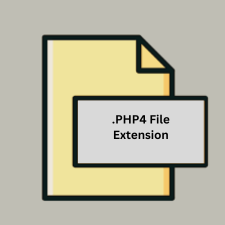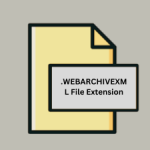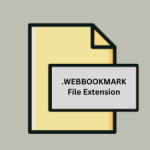.PHP4 File Extension
What is an PHP4 file?
.PHP4 files are web page files that use the PHP 4 scripting language. PHP stands for Hypertext Preprocessor, and it is a widely-used open-source server-side scripting language designed for web development. PHP 4 was a major version of PHP that introduced several features to enhance the language’s functionality.
More Information.
PHP 4 was designed to address the growing needs of web developers by offering better performance, more robust features, and improved support for web applications. It included a new Zend Engine, which improved its speed and efficiency. The primary purpose of PHP 4 files is to generate dynamic web content by processing PHP code embedded within HTML.
Origin Of This File.
The .PHP4 file extension originated from the PHP (Hypertext Preprocessor) language, which was created by Danish-Canadian programmer Rasmus Lerdorf in 1993. PHP 4, which these files specifically relate to, was released on May 22, 2000. It was a significant improvement over its predecessor, PHP 3, with enhanced performance and features.
File Structure Technical Specification.
A .PHP4 file is essentially a text file that contains PHP code along with HTML. The PHP code is enclosed in PHP tags (<?php ... ?>), and this code is processed on the server before the resulting HTML is sent to the client’s browser. The file structure is similar to that of .PHP files but may include syntax or functions specific to PHP 4.
How to Convert the File?
Windows
- Update PHP Code:
- Manual Code Review: Open the
.PHP4file in a text editor like Notepad++, Sublime Text, or Visual Studio Code. - Check Deprecated Features: Look for deprecated functions and syntax in PHP 4 code. Use the PHP documentation for newer versions to replace deprecated features with updated equivalents.
- Code Modernization: Refactor the code to utilize features from PHP 5 or newer versions. For example, replace old MySQL functions (
mysql_*) with PDO or MySQLi.
- Manual Code Review: Open the
- Testing:
- Set Up a Local Server: Use XAMPP or WAMP to create a local server environment with PHP 5 or higher.
- Run Tests: Place the updated
.PHP4file in the web server’s root directory (e.g.,htdocsin XAMPP). Access the file through your web browser to ensure functionality.
- Deploy:
- Upload to Server: After successful testing, upload the updated files to your live server that supports the newer PHP version.
Linux
- Update PHP Code:
- Open Code: Use text editors such as Vim, Nano, or Gedit to open and edit the
.PHP4file. - Check Deprecated Features: Identify and replace deprecated features with modern PHP functions and practices.
- Code Modernization: Update the code for compatibility with PHP 5 or higher.
- Open Code: Use text editors such as Vim, Nano, or Gedit to open and edit the
- Testing:
- Local Server Setup: Install a local server environment like LAMP (Linux, Apache, MySQL, PHP) and ensure it has PHP 5 or higher.
- Run and Test: Place the file in the web server’s root directory (e.g.,
/var/www/html) and test in a web browser.
- Deploy:
- Server Upload: After testing locally, upload the updated
.PHP4files to your production server with the appropriate PHP version.
- Server Upload: After testing locally, upload the updated
MAC
- Update PHP Code:
- Edit File: Open the
.PHP4file using text editors like TextEdit, Sublime Text, or Visual Studio Code. - Update Syntax: Refactor code to use functions and features compatible with PHP 5 or later.
- Edit File: Open the
- Testing:
- Set Up Local Server: Install MAMP or use the built-in PHP server on macOS if available.
- Test Code: Place the file in the web server’s directory (e.g., MAMP’s
htdocs) and verify functionality through a browser.
- Deploy:
- Upload to Production: After testing, upload the converted files to your live server that supports the newer PHP version.
Android
- Update PHP Code:
- Edit Files: Use a text editor app like QuickEdit or AIDE to open and edit the
.PHP4file. - Modernize Code: Update the PHP code to be compatible with PHP 5 or later.
- Edit Files: Use a text editor app like QuickEdit or AIDE to open and edit the
- Testing:
- Local Server App: Use apps like KSWEB or Palapa Web Server to run a PHP environment on Android.
- Run Tests: Place the file in the web server’s directory and test it through the local server app’s browser.
- Deploy:
- Upload Files: Transfer updated files to a live server with a compatible PHP version for final deployment.
iOS
- Update PHP Code:
- Edit Files: Use code editors like Textastic or Koder to open and modify the
.PHP4file. - Update Code: Replace outdated PHP functions and syntax with modern equivalents.
- Edit Files: Use code editors like Textastic or Koder to open and modify the
- Testing:
- Remote Testing: Since running a local PHP server on iOS is not practical, upload the file to a staging server with PHP 5 or higher.
- Access via Browser: Test the updated file through a web browser to ensure it functions correctly.
- Deploy:
- Final Upload: After successful testing, upload the converted files to your production server.
Others (General Approach)
- Update PHP Code:
- Text Editor: Use any text editor that supports PHP syntax to open and modify the
.PHP4file. - Code Refactoring: Update the PHP code to ensure compatibility with newer PHP versions.
- Text Editor: Use any text editor that supports PHP syntax to open and modify the
- Testing:
- Local Server: Set up a local server environment with PHP 5 or higher (e.g., XAMPP, WAMP, LAMP, MAMP, etc.) depending on your operating system.
- Test Thoroughly: Place the updated file in the web server’s root directory and test it to ensure it works correctly.
- Deploy:
- Upload to Production: Once testing is complete, deploy the updated files to your live server.
Advantages And Disadvantages.
Advantages:
- Performance: PHP 4 introduced significant performance improvements over PHP 3.
- Session Management: Enhanced session handling capabilities.
- Object-Oriented Programming: Better support for OOP compared to PHP 3.
Disadvantages:
- Security: PHP 4 has known security issues and lacks many security features present in later versions.
- End of Life: PHP 4 is outdated and no longer supported, which means it does not receive security updates or bug fixes.
How to Open PHP4?
Open In Windows
On Windows, you can open and edit .PHP4 files using text editors like Notepad++, Sublime Text, or Visual Studio Code. For execution, you need a web server with PHP installed (such as XAMPP, WAMP, or IIS with PHP).
Open In Linux
On Linux, .PHP4 files can be opened and edited using text editors like Vim, Nano, or Gedit. For executing the file, you need a web server like Apache or Nginx with PHP 4 installed.
Open In MAC
On macOS, you can open and edit .PHP4 files using text editors such as TextEdit, Sublime Text, or Visual Studio Code. You will need a web server like MAMP or a local server environment to execute the file.
Open In Android
On Android, you can view and edit .PHP4 files using file management apps or text editors like QuickEdit or AIDE. To execute PHP code, a local web server app like KSWEB or Palapa Web Server is required.
Open In IOS
On iOS, you can open and edit .PHP4 files using apps like Textastic or Koder. For execution, you would need a remote server with PHP 4 or use a web-based IDE that supports PHP.
Open in Others
.PHP4 files are text files and can be opened with any text editor. For executing the PHP code, a server environment with PHP 4 installed is necessary. Many modern development environments have replaced PHP 4 with more recent versions, so converting and updating the code is recommended.














